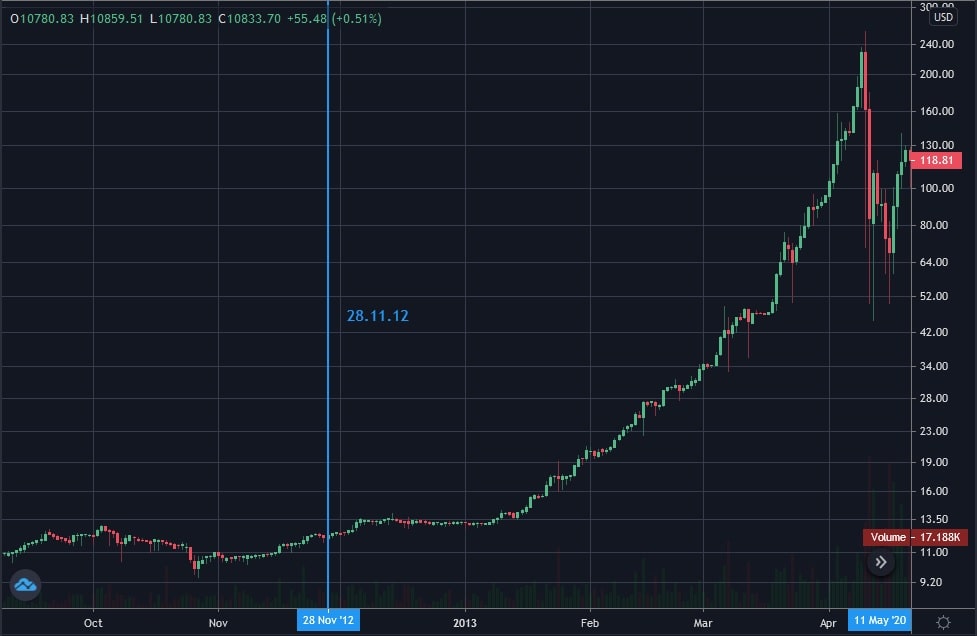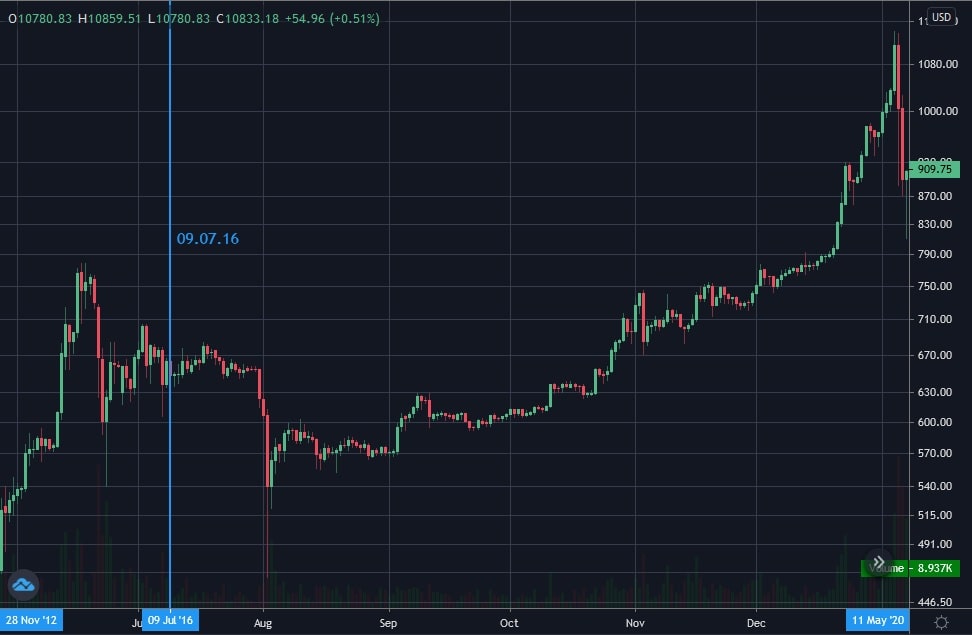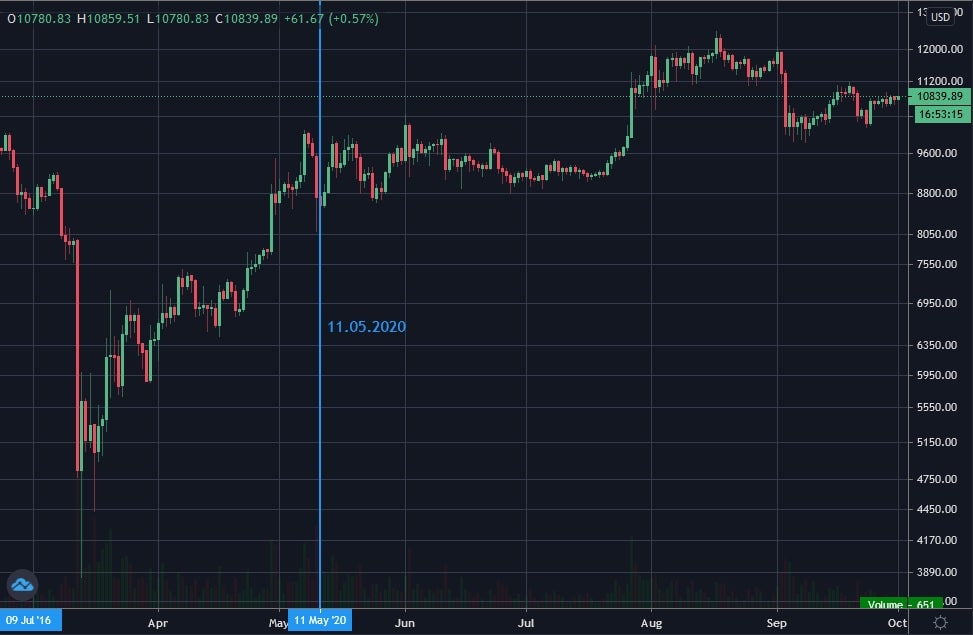What is a Bitcoin halving?
New Bitcoins are created on the Bitcoin blockchain as a reward for keeping it running by verifying transactions and adding them to blocks. This process is called mining. The miner who was the first to find a solution to a complex mathematical problem adds transactions to the block and receives a reward that includes a certain fixed amount of newly created Bitcoins, plus fees for transactions included in the block. A new block is added approximately every 10 minutes. Thus, the existing amount of Bitcoins increases by a certain amount every 10 minutes.
Bitcoin halving is an event pre-programmed by the Bitcoin algorithm that cuts the number of new Bitcoins in the mentioned above block reward in half. When Bitcoin was first launched, the block reward was 50 BTC. Given that the halving event has occurred three times since then, the current block reward is 6.25 BTC.
Thus, halving is a slow and predictable process of decreasing the number of newly created Bitcoins that will continue until the influx of new coins into the Bitcoin network is reduced to zero.
When is Bitcoin halving?
Bitcoin halving is an event that is programmed to happen at a certain frequency. And although its exact time can't be predicted in advance, the closer it is, the more accurate the forecast of the date is.
How often is Bitcoin halved?
Bitcoin halvings are triggered not by date but by the length of the Bitcoin blockchain. The Bitcoin algorithm is designed so that a Bitcoin halving event occurs after every 210,000 blocks mined. Considering that one block's addition occurs approximately every 10 minutes, halvings happen roughly every 4 years.
Bitcoin halving 2020
The last Bitcoin halving by the current date took place on 11 May 2020, causing the block reward to fall from 12.5 to 6.25 Bitcoins.
Pre-halving period
The first block of Bitcoin blockchain, also known as "Genesis Block" or "Block 0", was mined on 3 January 2009 by the coin's enigmatic creator, known only as Satoshi Nakamoto. The creator of Bitcoin set the initial block reward at 50 BTC. Since Bitcoin had no monetary value in those days, there was no real incentive to participate in mining, and Satoshi was almost the only miner. However, as early as 17 March 2010, BitcoinMarket.com became the first-ever Bitcoin exchange. That caused a surge of interest in the new currency, and, in spring 2011, the price of Bitcoin surpassed $1.
Although 50% of available Bitcoins were mined within that rather short period before the first halving and the supply of Bitcoin grew at a fairly rapid pace, Bitcoin's price at that stage increased from $0 to $12.
Pre-halving period
| Date | 3 January 2009 |
| Block number | 0 |
| Block reward, BTC | 50 |
| BTC created per day | 7200 |
| BTC price at the start | N/A |
| BTC price 100 days later | N/A |
| BTC price 1 year later | N/A |
Bitcoin halving 2012
The first halving took place on 28 November 2012. At first, the halving had no noticeable effect on Bitcoin's price. However, at the beginning of 2013, the coin's value began to steadily grow, and, in April, it gave way to a correction and continued again in autumn 2013, ending above $1,100. This was followed by a prolonged fall in prices, which went down to $152 on 14 January 2015. Finally, in October 2015, 9 months before the next halving, steady growth began again.
First halving
| Date | 28 November 2012 |
| Block number | 210,000 |
| Block reward, BTC | 25 |
| BTC created per day | 3600 |
| BTC price at the start | $12 |
| BTC price 100 days later | $42 |
| BTC price 1 year later | $964 |

Bitcoin halving 2016
The second halving took place on 9 July 2016. That date was highly anticipated by the crypto community. These expectations, coupled with a sharp rise in Bitcoin's renown and acceptance, led to a noticeable price increase that began at the end of May, a month and a half before the halving. However, a correction took place in mid-June, and, soon after the halving itself, the price fell again with its local minimum reaching May levels.
As it later turned out, that was only a short-term correction. The bullish trend soon continued and developed into exponential growth. This growth peaked on 17 December 2017, when the price reached its all-time high of $19,700. After that, a long bearish trend set in.
There were several reasons for this spike in price; it's impossible to say what part halving played. In 2017, the popularity and acceptance of Bitcoin and other cryptocurrencies grew rapidly, attracting a large number of new participants to the crypto market. That, in turn, led to the emergence of an 'ICO bubble', which further increased demand for Bitcoin since many ICOs accepted it.
Second halving
| Date | 9 July 2016 |
| Block number | 420,000 |
| Block reward, BTC | 12.5 |
| BTC created per day | 1,800 |
| BTC price at the start | $663 |
| BTC price 100 days later | $609 |
| BTC price 1 year later | $2550 |

Bitcoin halving 2017-2019
There were no halvings during these dates.
Bitcoin halving 2020
The third halving, which took place on 11 May 2020, as well as the previous Bitcoin halving, did not cause an immediate price increase. It's true that growth began on earlier halving dates at the beginning of the year, but the coronavirus crisis that started in March caused Bitcoin's price to collapse. This makes it even more difficult to assess how much halving is already factored into the price. At the same time, it should be taken into account that the current amount of Bitcoin being mined is quite small compared to the total amount of Bitcoin traded, and it is unlikely that a relatively small drop in supply can cause a significant price increase. Thus, a possible further increase in the price of Bitcoin will be much more influenced by a growth in demand than a reduction in supply.
Third halving
| Date | 11 May 2020 |
| Block number | 630,000 |
| Block reward, BTC | 6.25 |
| BTC created per day | 900 |
| BTC price at the start | $8740 |
| BTC price 100 days later | $11,950 |
| BTC price 1 year later | N/A |

The next Bitcoin halving
The next halving is expected around 2024. It will drop the block reward to 3.125 BTC.
Fourth halving
| Date | Around 2024 |
| Block number | 840,000 |
| Block reward, BTC | 3.125 |
| BTC created per day | 450 |
Future Bitcoin halvings
Bitcoin halvings will repeat approximately every 4 years until the block reward becomes equal to zero. After that, the only reward for miners will be the commissions for transactions included in the block. Although this can have severe negative consequences for the Bitcoin network, its participants have every chance to find a solution to this problem.
This article does not contain investment advice or recommendations. Every investment and trading move involves risk, and readers should conduct their own research when making a decision.
